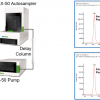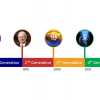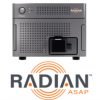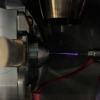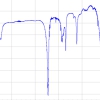Antony N. Davies,a,b Mark F. Wyattc and Bridget K. Steinc
aSERC, Sustainable Environment Research Centre, Faculty of Health, Sport and Science, University of Glamorgan, UK
bDirector, Analytical Laboratory Informatics Solutions
cEPSRC National Mass Spectrometry Service Centre, Institute of Mass Spectrometry, School of Medicine, Swansea University, Swansea SA2 8PP, UK
Introduction
The are many self-styled “Centres of Excellence” springing up around Europe—often used more as a marketing tool in the ever more difficult battle for funding than as a validateable descriptor of actual performance. It was therefore extremely pleasant to encounter an organisation which can clearly and proudly lay claim to this title should they wish: the EPSRC National Mass Spectrometry Service Centre located in the School of Medicine at Swansea.
Swansea University has a long tradition of excellence in mass spectrometry going back to the Royal Society Research Unit here in the 1970s followed by the Mass Spectrometry Research Unit and now the EPSRC National Mass Spectrometry Service Centre which works with its umbrella organisation the 2007 Institute of Mass Spectrometry in the College of Medicine. Looking back, for example, to the work of the Professor Dai Games and his close associates we can see the influence of the work carried out at Swansea in mass spectrometry right across this field. A tradition which is being upheld by the current teams under the directorship of Professor Gareth Brenton and management of Bridget Stein.1
The EPSRC “Service” Centre
Why highlight this organisation this issue? Well as part of an ongoing research project we were struggling with the analysis of certain tricky new materials and someone pointed out that there was an organisation whose reason-for-being actually covered assisting us in this area... and of course they were located just up the road!
I called Bridget Stein and she was extremely helpful on the phone, guiding me through the background to the existence of the Centre “...to underpin high-quality chemical research in the UK by provision of state-of-the-art mass spectrometry for EPSRC supported research groups”. They support on average just under 1000 scientists from organisations across the UK per year and supply data for thousands of publications and patents. They also have a training remit as can been seen, for example, by the annual Summer School and Best Practise Guide for Generating Mass Spectra produced with Vicky Barwick of the LGC, John Langley from University of Southampton, Tony Mallet at the University of Greenwich and Ken Webb.2
Bridget highlighted the capabilities of the Centre as well as the procedures for registering ourselves with the NMSSC and then for submitting samples for analysis.
Submitting samples
The simple and easy to navigate STAR (Sample Submission, Tracking, Analysis and Results) interface is available from the NMSSC website. This serves not only for registered scientists to enter information about the analytes they wish to be studied and varying levels of detail can be requested, but also as the main submitter administrative tool for the different client organisations. Once an account or “Allocation Holder” has been configured by the Centre staff then these customer superusers can create their own local submitter lists.

Talking to Mark Wyatt (Figure 1), one of the Centre’s spectroscopists, during our visit, he pointed out that obviously the better the quality of the information provided by the sample submitter the easier it is for the Centre staff to carry out the analyses. Clearly they have by far the best oversight of what their underlying capabilities are, and I would strongly recommend a quick chat with them around your specific problems when you start using the service. It could well save them and yourselves a lot of time and effort. Information you will be requested to provide includes:
- Your sample reference—carried through the whole of the process and also used on the results provided by the Centre back to the individual submitters so that you do not need to keep referring back through the Centre’s own reference numbers—a nice touch which saves time for the submitters.
- Molecular formula, molecular weight and a molecular structure if you have enough information on your sample to provide this!
- Any melting points you may have determined and solubility information.
- Last but not least, the relevant Health & Safety information needs to be provided for your samples.
You can let the Centre staff decide on the best way to approach your samples opting for “Let us decide” or be more specific in your needs opting for EI, CI, ESI, FAB, MALDI with more details if accurate mass is required, or tandem methods such as GC/MS or LC/MS.
I was especially pleased to see the use of CHIME (Figure 2) for embedding the uploaded chemical structures into the web pages used for sample tracking!3

The results for our samples were e-mailed to us in a standard PDF/A format so that nobody should have any difficulties in opening the files regardless of the software they have deployed. Finally, the proof of the pudding—as they say—is in the eating and Gene and our team have been very happy with the results we have received from the service where on a particularly difficult synthesis our own nuclear magnetic resonance and mass spectrometry data was inconclusive and the help of the NMSSC team was invaluable in indicating in which direction the team needed to progress to get to our target molecules.
Thanks again to Bridget and the team and keep your eyes open for the publications!
References
- More information on the NMSSC can be found at http://www.nmssc.ac.uk
- LGC Ltd, Teddington, UK (2007), ISBN: 978 0 948926 24 2. http://www.vam.org.uk/publications/publications_item.asp?intPublicationID=1328
- CHIME, http://accelrys.com/products/informatics/cheminformatics/chime/no-fee.php



